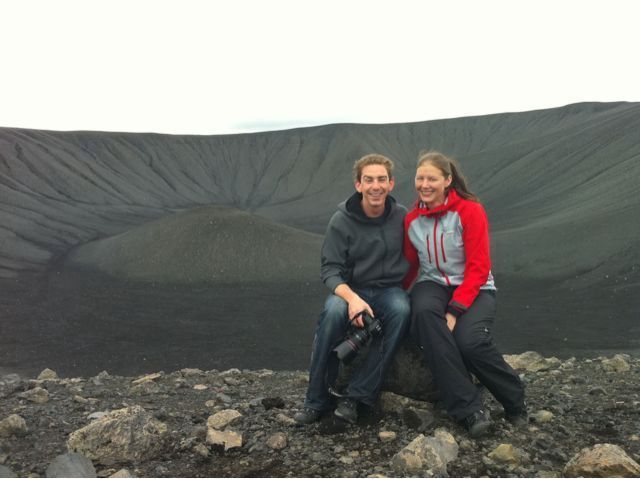Today we woke up bright and early in the small lakeside town of Reykjahlíð, surrounded by the apocalyptic volcanic landscape of the Myvatn region.
The entire area surrounding Myvatn Lake is bubbling with volcanic activity, and remains very active to this day. It sits on top of the Mid-Atlantic Ridge, and had a landscape unlike anywhere else in Iceland. Scanning the horizon, you can see plumes of sulfur steam coming from vents, and volcanic cones and craters looming.
We started the day after packing up the campsite by driving straight over to the nicest, and only hotel in town, Hotel Reykajahlid for a long awaited buffet style breakfast. We got our helping of eggs and bacon and toast, and then headed out to hike up to the Hverfell volcanic crater. The 463m high crater is about 2500 years old, and was formed as part of the Ludentarhid eruption. After a brief hike around there, surveying the dry crater with recently created lava dome at the bottom, we hopped back in the car, and drove a short ways down the road to the Dimmuborgir area. Here, in recent geologic history, a large underground lake was covered with magma, which vaporized the lake, forcing steam out of the earth through large, spindly steam vents made of cooled lava. We did the hour long “Church Circle” hike around the whole area, exploring lava tubes, collapsed ceilings, and caves made by cavities in the lava. It was quite stunning to see how much diversity can be created from the variety of geologic events.
After Dimmuborgir, we headed over for a long awaited soak in the Myvatn Nature baths. Here, the sulfur-rich water comes out of the ground at a scalding 100 degrees Celsius, and is eventually cooled to a manageable temperature, and pumped into a public pool. The experiences sitting in a bubbling, steaming, geothermally heated pool in this volcanic wasteland was very dramatic, and afterward, Sari, Petra and I relaxed in the cafe for some tea, before moving on.
By far the most interesting stop of the day was the Leirhnjukur lava flow and Krafla Caldera. This field of hardened lava was created in 1727 and is so recent that there are still huge plumes of sulfur steam coming out of the rocks. The hike around was incredible, and it felt like we were in another world, with intricately hardened rock domes, needles, flows, and tubes running all over the place, amidst a fog of sulfur.
Finally, before hitting the road to Sedisfjordur, we stopped at the bubbling mud field Namafjall. Here, the ground is still hot from volcanic activity, and the field is covered with bubbling pools of mud, superheated by the magma below. The terrible sulfur stench of the place was barely manageable, but we took a good walk around the area, and marveled at how many formations the volcanic activity could make.
From there, we got back in the car, and and after dropping Petra off at the campground in Egilsstadir made it to our campground in Seydisfjordur.
Tonight, this town has been amazing – we’re staying in the quaint campground, and made it over to the local restaurant/gallery/bar/coffee house for a round or two, and a chat with the locals.
Tomorrow, we’re looking forward to a twisting drive down the eastern Icelandic coast, all the way to the mountain town of Skatafell.




